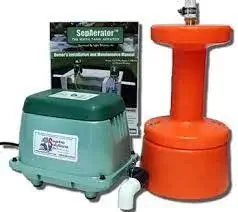Introduction
Septic tank diffusers play a crucial role in maintaining the health and functionality of your septic system. These small but powerful devices help aerate the wastewater in your septic tank, promoting the breakdown of organic matter and preventing the accumulation of harmful gases. In this article, we will explore the power of septic tank diffusers, their benefits, how to choose the right one, maintenance tips, common issues, and how they compare to other aeration systems.
How Septic Tank Diffusers Work
Septic diffusers are designed to introduce oxygen into the aerobic septic tank, creating an ideal environment for the growth of aerobic bacteria. These bacteria are responsible for breaking down the organic waste and converting it into harmless byproducts. The diffusers are typically installed at the bottom of the septic tank, where they release fine bubbles of air. These bubbles rise through the wastewater, providing oxygen to the bacteria and facilitating the decomposition process.
By enhancing the level of oxygen in the septic tank, diffusers promote the growth of aerobic bacteria, which are more efficient in breaking down waste compared to anaerobic bacteria. This leads to better decomposition, reduced accumulation of sludge, and improved overall system performance.
Benefits of Using Septic Tank Diffusers
Using septic diffusers offers several advantages for homeowners with septic systems:
- Improved wastewater treatment: The introduction of oxygen through diffusers enhances the treatment process, resulting in cleaner effluent that is less harmful to the environment.
- Reduced odors: Proper aeration helps prevent the release of foul-smelling gases, keeping your property free from unpleasant odors.
- Extended system lifespan: By promoting efficient decomposition, diffusers help prevent the accumulation of sludge and prolong the lifespan of your septic system.
- Lower maintenance costs: A well-maintained septic system with diffusers is less likely to experience costly issues such as clogs, backups, or drain field failures.
Choosing the Right Septic Tank Diffuser
When selecting a septic tank diffuser, there are a few key factors to consider:
- Type of diffuser: There are various types of diffusers available, including fine bubble diffusers, coarse bubble diffusers, and membrane diffusers. Each type has its own advantages and considerations. Consult with a septic professional to determine the best option for your specific needs.
- Tank size and capacity: The size of your septic tank and the volume of wastewater it handles will impact the size and number of diffusers required for effective aeration.
- Durability and maintenance: Look for diffusers made from durable materials that are resistant to clogging and easy to clean. Regular maintenance is essential to ensure optimal performance.
- Energy efficiency: Some diffusers consume more energy than others. Consider energy-efficient options to reduce operational costs.
Maintenance Tips for Septic Tank Diffusers
Proper maintenance of septic diffusers is crucial for their long-term performance. Here are some essential maintenance tips:
- Regularly inspect the diffusers for any signs of damage or clogging.
- Clean the diffusers periodically to remove any accumulated debris or sediment.
- Check and clean the air filters to ensure proper airflow.
- Monitor the performance of the diffusers and consult a professional if you notice any issues.
Following these maintenance tips will help ensure that your septic diffusers continue to operate effectively, prolonging the lifespan of your septic system.
Common Issues with Septic Tank Diffusers
While septic diffusers are generally reliable, there are some common issues that may arise:
- Clogging: Diffusers can become clogged with debris or biofilm over time, leading to reduced airflow and diminished performance.
- Damaged membranes: Membrane diffusers can develop cracks or tears, affecting their ability to release air bubbles evenly.
- Uneven distribution: In some cases, diffusers may not distribute air evenly throughout the septic tank, resulting in inefficient aeration.
- Overloading: If the diffusers are not properly sized and matched to the septic tank’s capacity, they may struggle to handle the volume of wastewater, leading to reduced performance.
Addressing these issues promptly and seeking professional assistance when necessary will help maintain the effectiveness of your septic tank diffusers.
Septic Tank Diffusers vs Other Aeration Systems
While septic tank diffusers are a popular choice, there are alternative aeration systems available. Here’s how diffusers compare to other options:
|
Septic Tank Diffusers |
Other Aeration Systems |
|
Relatively affordable |
Varies depending on the type and complexity |
|
Effective in most residential septic systems |
Can be tailored to different system sizes and requirements |
|
Low energy consumption |
Energy requirements may vary |
|
Easy installation and maintenance |
May require professional installation and more complex maintenance |
Ultimately, the choice between septic diffusers and other aeration systems depends on factors such as budget, system size, and specific needs. Consulting with a septic professional will help determine the best solution for your septic system.
Frequently Asked Questions
Here are some commonly asked questions about septic tank diffusers:
Final Thoughts
When it comes to septic tank diffusers, it is crucial to choose the right type and size for your septic system. Consulting with a septic professional will help ensure that you make an informed decision. Regular maintenance, including cleaning and inspection, is essential to keep your diffusers operating at their best. If you experience any issues or notice a decline in performance, do not hesitate to seek professional assistance.
Remember, a well-maintained septic system with properly functioning diffusers can provide reliable and efficient wastewater treatment for years to come.
